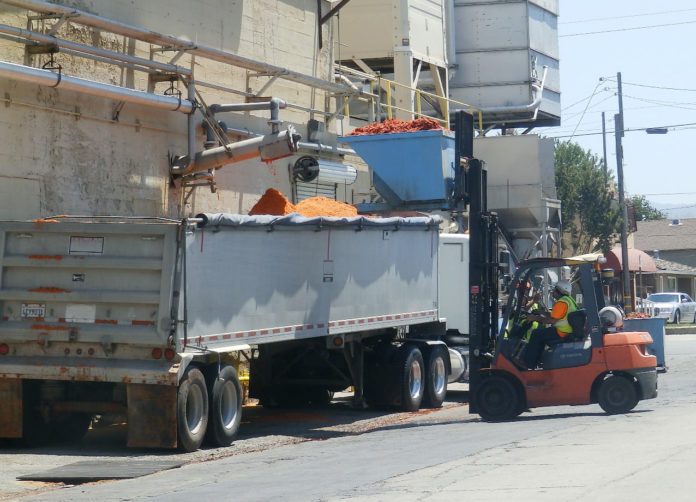A Hollister staff report from City Manager Bill Avera addressed two 2016 wastewater spills by stressing that less than 39,000 gallons of effluent reached the San Benito River bed.
Avera’s downplaying of the damage led off the 66-page report obtained by the Free Lance. It included details about a failed diversion valve near downtown that caused the breaches, corrective actions taken to mitigate the spills, an agreement with an engineering consultant, and a timeline of events presented by the city’s top staff official.
The Central Coast Regional Water Quality Control Board issued Hollister a notice of violation Jan. 13 related to two 2016 sewage spills discharged into the San Benito River bed. The first spill happened on or around July 16, and the second occurred Sept. 6. The water board requires submission of information, including a technical report, by Feb. 27.
Those spills happened last summer, but city officials never issued a public notice about the matter. Instead, city staff members filled the related leak of a diversion valve in a sewer line with inflatable plugs, one of which eventually failed.
The city also failed to inform proper state and local authorities upon discovery of the spills, as pointed out in the notice of violation.
Those spills came nearly 15 years after 15 million gallons of wastewater spilled into the San Benito River bed and prompted the state to force Hollister to build a new, eight-figure treatment plant while enacting a building moratorium until its completion. The local economy was hammered by the moratorium, which affected housing, industrial jobs and commercial development for more than a half-decade. At the time of the spill, city officials blamed the breach on a gopher hole.
Avera issued his response on the matter to council members six days after receiving the state’s violation notice.
Failed equipment
The memo report, sent from Avera to city council members, summarized actions from the July 16 spill to that point.
It stated the City of Hollister has a dual-system for storm drainage and industrial waste that moves water from the San Benito Foods cannery to the Industrial Wastewater Treatment Plant on the west side. The document pointed out that the substance moved from the cannery to the treatment plant is water and organic tomato waste, not sewage.
The notice of violation from the water board, however, referred to the cannery waste as sewage.
“After years of wear, the slide gate was leaking at the diversion point at West Street,” the Avera report stated. “This caused tomato waste to enter the storm drain system and approximately 200 gallons of material may have made it to river channel. The City contacted all the affected agencies but did not meet the threshold of a significant event.”
Corrective actions taken
The official spill report submitted to the state water board was included in the city memo. It detailed corrective actions taken by Hollister, such as the following:
Water-quality samples were taken at the Apricot Lane storm drain outfall Aug. 2. Sandbags were installed in the ditch for containment that same day. On Aug. 5, city staff used a six-inch bypass pump to divert flow from the ditch into treatment plant pond No. 1. Additional sandbags were used for containment on Aug. 10. The leak through the slide-gate was successfully stopped by installing an inflatable plug in the Apricot line at the gate on Aug. 11. The line was monitored on closed circuit television (CCTV) for “deficiencies and necessary repairs.”
“The City continues to monitor the situation to ensure that no further leakage occurs as the City develops and implements a long-term solution; the City is consulting with a professional engineering firm to evaluate appropriate alternatives for a long-term solution and implementation,” the report read.
The memo confirmed previous Free Lance reporting on the use of two inflatable plugs to stop the leak. The first plug broke Sept. 6, resulting in a second sewage spill.
“Approximately 38,000 gallons of tomato waste made it to the river,” Avera reported.
“Affected agencies were called again, and direction was given to clean up the material by fish and wildlife and no permit was required.”
The city report to the state water board noted that workers stopped the discharge by installing a new plug at the slide-gate.
Read the entire 66-page Avera report here.
Avera in a previous interview noted that much more waste is produced each day at the cannery, the sole user of the domestic treatment pond on Hollister’s west side, than the amount spilled.
In the memo, Avera took a similar tone.
“Over the 56 days of the two events and cleanup, the conservative number of 600,000 gallons is far less than 1 percent of the approximately 120 million gallons of material processed,” Avera said in the memo. “All but the reported 38,481 gallons that did reach the dry river bed was contained and pumped appropriately into the plant.”
For frame of reference, the total spill volume for July 16 was 600,000 gallons, with 200 gallons reaching the San Benito River bed, according to the notice of violation.
The total spill volume for Sept. 6 was 338,524, with 38,481 gallons reaching the river.
Additionally, the two spills are possibly related to a stronger-than-usual odor of cannery waste that wafts through town every summer.
On Oct. 18, the Monterey Bay Air Resources District sent notice of a fine to the City of Hollister for $1,139 over the unpleasant summer smell that lasted for weeks in parts of the community in 2016, and spurred complaints by local residents like the mayor.
According to the notice of violation, state water board staff received an odor complaint on July 30 that indicated the odors related to tomato processing and wastewater disposal.
Avera noted the $1,139 in the memo’s timeline of events.
Engineering consultant
Avera’s report stated that city staff members started working with the Wallace Group, a San Luis Obispo-based engineering consultant, in October to find an “appropriate alternative” to permanently fix the slide-gate failure at the diversion point.
A memo from the Wallace Group sent to the city on Oct. 17 provided analysis of the existing diversion structure.
According to the Wallace Group memo, the existing diversion structure is a six-foot diameter manhole (approximately 13-feet deep) with one 18-inch sewer main inlet, one 18-inch sewer main outlet to the treatment plant and one 24-inch storm drain outlet to the Apricot Lane Outfall.
“During the summer, the slide gate to Apricot Outfall is closed, while the slide gate to the (treatment plant) is open and vice versa during the winter,” the Wallace Group memo stated. “The City (sic) installed the stainless steel slide gates after the previous metal slide gates failed due to the highly corrosive tomato waste. If a failure occurs on the storm drain outlet gate, then tomato wastewater will flow to the Apricot Outfall, requiring the City to report the discharge as a spill to the Regional Water Quality Control Board (RWQCB).”
Council members approved the design concept of a prefabricated fiberglass unit Nov. 7. The unit is more resistant to the acidic material, the report stated. Design concepts were also approved for a secondary gate for backup containment.
The Nov. 7 meeting staff report stated the stainless-steel slide gate and the concrete used to seal around it react to the high corrosiveness of the tomato waste.
Council members approved the plans and specifications for the project at their Jan. 17 meeting. Hollister is currently processing a purchase order for the unit, with construction expected to be completed before the cannery begins production this summer, the memo read.
The Wallace Group memo provides a glimpse at the cannery’s wastewater flow rate and temperatures.
“During the summer operations, approximately 2.0 mgd (million gallons per day) of tomato wastewater constantly flows through the manhole at a relatively high velocity and high temperature,” the memo noted. “Temperatures range between 120-130 degrees, and can reach as high as 160 degrees. The tomato wastewater banks 90 degrees off of the closed slide gate to the Apricot Outfall, and then flows to the (treatment plant).”
The memo stated that concrete was built up behind the slide-gate to seal the outlet due to the rectangular shape of the gate, which was located in a round manhole. It goes on to talk about the two sewage spills.
“In the summer of 2016, the high velocities and the corrosive tomato wastewater eroded the concrete behind the slide gate and caused wastewater to bypass the slide gate into the downstream storm water collection system. In late July/early August 2016, the tomato wastewater reached the unlined channel downstream of the Apricot Outfall, but was contained prior to reaching the San Benito River.”
It should be noted that approximately 200 gallons reached the San Benito River bed during the July 16 spill, according to the water board’s notice of violation.
The memo goes on to address the Sept. 6 spill.
“In late August, 2016, the plug failed and more tomato wastewater flowed to the Apricot Outfall channel and ultimately reached the San Benito River,” the report said.
Timeline of events as presented in the Avera report:
The following is a timeline of events associated with faulty slide gate:
7/25/16 – Odor Returns
8/2/16 – City conducts water samples and sandbags placed in the ditch for containment.
8/8/16 – Tomato Waste discovered in the drainage channel which leads from the Apricot outfall to the San Benito River
Staff dammed the channel with sandbags approximately halfway down the channel
A 6” pump was rented and installed to pump the tomato from the channel back to the IWTP ponds
The Pump was run 24 hours a day for 5 days
A second wall of sandbags was installed further down the channel to address a small amount of tomato seepage that was occurring at the first sandbag wall.
At this point approximately 200 gallons of tomato exited the channel into the riverbed.
The Water Board was notified
8/11/16 – Plug installed in the Apricot Storm Line, backup plug obtained
8/29/16 – Communication continues with the State Water Board
9/1/16 – Record of a plug inspection
9/2/16 – Record of a plug inspection
9/6/16 – Discovered second discharge into the channel and the river due to plug failure – 8am.
Pump immediately restarted (already onsite in position) – 8am.
Water Samples taken – 9am.
Dispatched additional pump equipment, Vac-con and a 3’ pump. -9:30am.
Notified State OES – 10am.
Backup plug installed – 11am.
Fish and Wildlife on site – 11:30am.
HFD called out to take samples for Fish and Wildlife 12:30pm.
Flow into channel stopped at 2pm.
Fish and Wildlife departed 2:30pm.
Health Department arrived at 3pm.
9/15/16 – Spill volume calculated at 600,000 gallons, approximately 38,000 gallons in river
9/16/16 – Communication between the Water Board and Fish and Wildlife regarding the planned clean-up, No permit required for cleanup.
9/29/16 – CIWQS report filed
10/18/16 – City receives a $1100 fine from the Air Resources Board
10/20/16 – City Council approves a task order for the Wallace group to design a repair for the failed infrastructure. Council report includes a report from Wallace detailing the spill on Page 2 of 5
11/1/16 – Freelance publishes an article reporting the $1100 fine from the Air Resources Board.
1/13/17 – The mayor received a letter from the Water Board notifying the City of Hollister of an investigation into several possible violations. The letter instructs staff to complete an additional report about the spill and threatens fines for non-compliance. To date no fine has been ordered.
1/17/17 – Freelance publishes article entitled ‘Hollister hit with penalty for two sewage spills into San Benito River’ No penalty has been assessed to date as the material is tomato waste, not sewage.
1/17/17 – Freelance publishes article entitled ‘Updated: City manager downplays sewer spills, blames equipment’.
Look back for more documents related to the 2016 wastewater spills.










